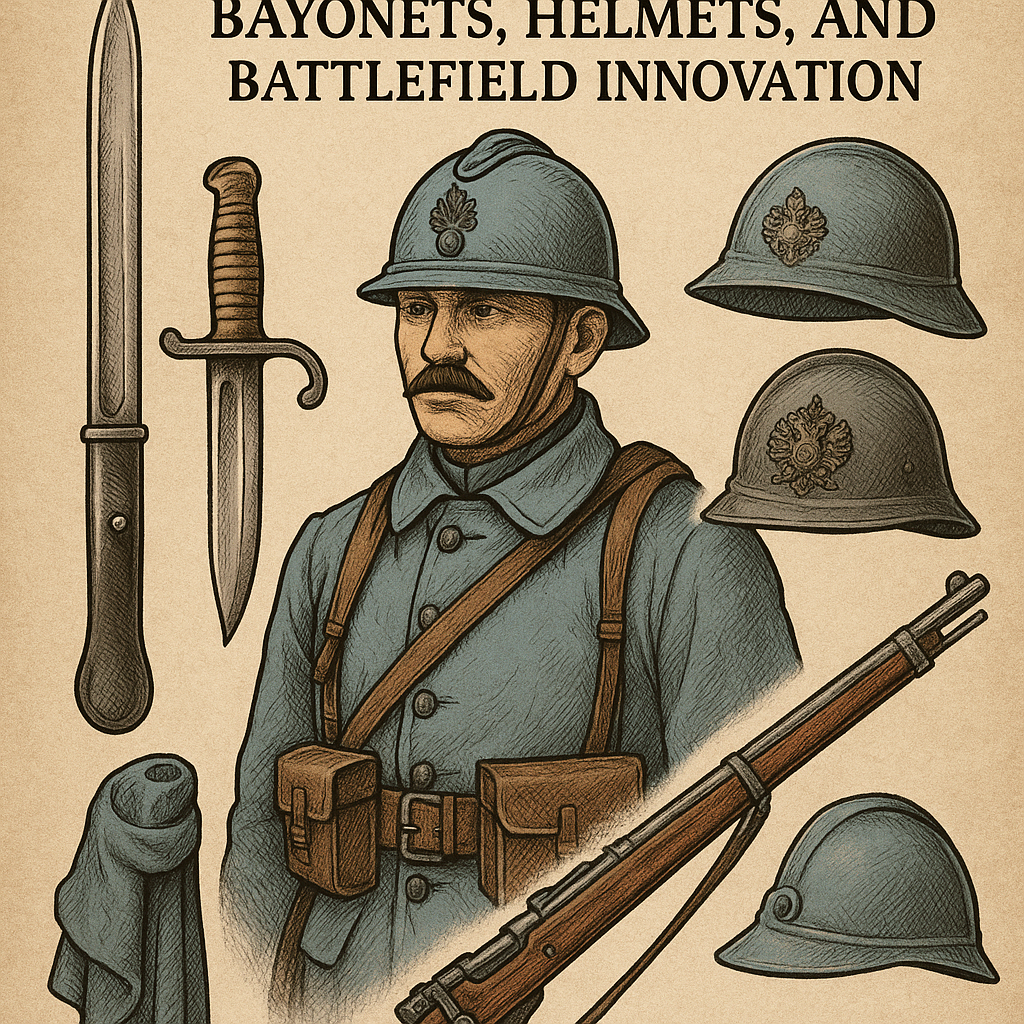
French Army WW1 Equipment: Bayonets, Helmets, and Battlefield Innovation
Published on May 23, 2025
French Army WW1 Equipment: A Legacy of Innovation and Endurance
When World War I erupted in 1914, European armies found themselves grappling with the harsh realities of modern warfare. Among them, the French Army stood out for its early adoption of innovative equipment that would come to define trench combat. The tools of war used by French soldiers were not just utilitarian—they were symbolic, carefully crafted, and incredibly influential. From the fearsome bayonet to the life-saving helmet, French military gear played a pivotal role in shaping the battlefield experience.
The Chassepot Bayonet: A Blade Designed for War
The Chassepot bayonet, officially known as the Model 1866 bayonet, is one of the most iconic weapons associated with the French military. It was initially paired with the Chassepot rifle, a bolt-action weapon that was ahead of its time in the 19th century. Yet, this bayonet continued to be widely used even into the early days of WWI.
Featuring a curved "yataghan-style" blade, this bayonet extended the reach of infantrymen in close-quarters combat. At about 22 inches long, the blade was intimidating and functional. Its brass handle offered a firm grip, even in muddy trenches, and the overall construction was both elegant and deadly.
Despite being developed in the 1860s, many French soldiers carried the Chassepot bayonet into World War I due to its proven effectiveness and robust design. For collectors today, it remains a prized piece of history.
Adrian Helmet: France’s Answer to Modern Warfare
Introduced in 1915, the Adrian helmet marked a turning point in battlefield safety. Trench warfare had dramatically increased the number of head injuries, and the French Army recognized the urgent need for better protection. Designed by General August-Louis Adrian, this helmet became one of the first modern combat helmets.
Made from mild steel, the Adrian helmet was lightweight and featured a distinctive crest along the crown, designed to deflect shrapnel. It also came with insignia representing different military branches—grenades for infantry, crossed cannons for artillery, and anchors for navy troops.
Not only did the helmet protect soldiers from shrapnel and debris, but it also offered a psychological boost. For the first time, soldiers felt that their heads—one of the most vulnerable parts of the body—had some level of protection.
Russian Use of the Adrian Helmet: An International Influence
One of the most intriguing aspects of the Adrian helmet is its global reach. During World War I, the Russian Empire faced significant shortages in equipment. Recognizing the effectiveness of the French design, they purchased approximately 1.5 million Adrian helmets to equip their troops.
The Russian version was typically adorned with the imperial double-headed eagle and painted to match Russian military uniforms. This marked an unusual but practical crossover of military technology between allies, and it further cemented the Adrian helmet’s reputation as a pioneering piece of protective gear.
French Uniforms and Additional Gear
In addition to helmets and bayonets, French soldiers carried a range of gear that reflected both tradition and necessity. Here's a quick overview of other essential WWI French Army items:
- Lebel Rifle: A bolt-action rifle that served as the standard issue for French troops. Known for its reliability, it remained in use throughout the war.
- Gas Masks: As chemical warfare became more common, gas masks evolved from makeshift protection to more advanced filtration systems.
- Horizon Blue Uniforms: Early in the war, French troops wore brightly colored uniforms that made them easy targets. They soon transitioned to "horizon blue" uniforms, a more subdued and camouflaged color that blended with the smoky battlefield.
- Entrenching Tools: Essential for building and maintaining trenches, these tools were part of every soldier's kit.
The Impact on Collecting and Historical Interest
Today, the legacy of French WWI equipment lives on not just in museums but also in private collections. Items like the Chassepot bayonet and Adrian helmet are highly sought after for their historical significance and distinctive design. They symbolize a time of rapid military innovation and highlight the bravery and resilience of the soldiers who carried them.
Collectors, reenactors, and history enthusiasts seek these artifacts as a way to preserve and honor the memory of those who served during the Great War. Authentic pieces are often displayed in historical exhibitions or worn during commemorative events.
Conclusion
The French Army's WWI equipment was far more than a collection of tools—it was a lifeline in the trenches, a product of innovation, and a template for future armies. The Chassepot bayonet and Adrian helmet, in particular, stand out as engineering marvels of their time. Their influence reached far beyond France, even shaping how allied nations, like Russia, outfitted their troops.
Understanding these pieces not only provides insight into military history but also offers a glimpse into the daily lives and struggles of soldiers who lived through one of the most brutal conflicts in modern history.
Whether you're a collector, historian, or simply a curious reader, the legacy of French World War I equipment is a fascinating journey into courage, innovation, and resilience.
